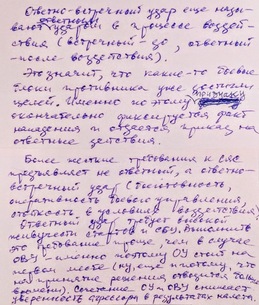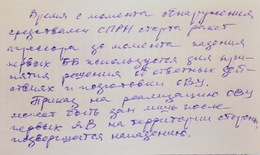A lot of what I know about Soviet nuclear forces and the Soviet military industry I learned from Gennady Khromov (Геннадий Константинович Хромов). He worked with the Military Industrial Commission since the 1960s and over the years was closely involved in many decisions regarding strategic modernization, arms control and disarmament. In the 1990s and early 2000s he was a prominent figure in the Moscow arms control community. I am sure many people remember his pointed questions and comments. Sadly, Gennady Konstantinovich Khromov passed away in 2007.
We have had quite a few conversations over the years, often not really structured around anything in particular. Gennady Khromov knew very much everything that was there to know about Soviet strategic programs and he was very open to sharing his knowledge. My role was mostly to absorb all that information and ask questions. He wouldn't give me all answers, by the way - as a true professional he knew the limits of secrecy very well. But what he was able to say was always accurate - for example, I don't remember seeing anything in the Kataev documents that would contradict what I have learned from Gennady Khromov.
I have a copy of the Russian Strategic Nuclear Forces book (the Russian edition) with Gennady Khromov's handwritten notes. I want to share two notes that I find particularly interesting - his comments on the "Operations of the strategic forces" section of the book (pp. 41-45 of the Russian edition, which are pp. 49-54 in the English edition). The comments deal with various nuclear strike scenarios - from first strike to launch-on-warning and to retaliation. As it turned out, the terminology that we used in the book was heavily influenced by the U.S. discussion of these options (not surprisingly, of course). However, Gennady Khromov pointed out that the approach that was used in the Soviet Union was somewhat different and these differences are important.
The image above is the first note, with my translation below. Since the whole point of this note is to provide accurate definitions of the terms otvetno-vstrechnyy udar (ответно-встречный удар), vstrechnyy udar (встречный удар) and otvetnyy udar (ответный удар), I've kept these terms transliterated.
Otvetno-vstrechnyy udar (OVU) is also called an otvetnyy udar under conditions of an attack (vstrechnyy - before the impact, otvetnyy - after).
This means that some attacking warheads have already reached their targets. This is exactly the sign that is used to definitively determine the fact of the attack and issue a command to initiate retaliatory actions.
Otvetno-vstrechnyy udar imposes more stringent requirements on strategic nuclear forces than otvetnyy udar (in terms of combat readiness, responsiveness of the combat command and control system, hardness against effects of a nuclear attack).
Otvetnyy udar does require the high degree of survivability of the launchers and of the combat command and control system. However, in the case of the otvetnyy udar these requirements are easier to satisfy than in the case of an OVU - this is exactly why OU is considered the primary option (well, also because it provides more decision time). A combination of OU and OVU reduces the aggressor's confidence in the results of his attack.
It is clear from the text that otvetno-vstrechnyy udar is what is known as launch from under attack. The term otvetno-vstrechnyy, however, is often used in the literature to refer to the launch-on-warning option. Which is apparently incorrect - what is normally understood as launch on warning would be the vstrechnyy udar option. The difference is quite important - according to Khromov, the Soviet Union has never relied on launch on warning and would wait for actual nuclear explosions on its territory before making the decision to retaliate.
Moreover, even the launch from under attack/otvetno-vstrechnyy udar was a relatively recent addition to the Soviet arsenal of options - it was a result of a focused effort undertaken in the early 1980s. The R-36M2 missile (SS-18 Mod 5) and probably RT-23UTTH (SS-24) as well were at the center of the program - all missile elements were hardened against the effects of a nuclear blast - from electronics to the missile body. This is how R-36M2 got its characteristic black coating - it apparently helped the missile to fly through a nuclear mushroom cloud. According to Khromov, this program, especially the electronics, was as expensive as the construction of hardened silos in the early 1970s.
It should also be noted that the conscious decision to adopt retaliation after ride-out/otvetnyy udar as the core strategic posture was also relatively recent - it was born during what is known as a "small civil war" in the late 1960s-early 1970s. It's fairly difficult to say if there was any specific strategy before that, though. My understanding is that it was largely left to circumstances and it is quite possible that some scenarios during the 1960s made room for a pre-emptive attack. But once the Soviet Union started to systematically consider its options, first strike was quickly eliminated - the Soviet Union never had a realistic first strike capability and unlike the United States was not enamored by the concept of damage limitation.
But why would the Soviet Union invest so much effort into deploying early-warning radars and satellites if it never planned to rely on that early warning? Launch on warning seems like a reasonable thing to do. The full story is rather complicated, but one thing is certain - the role of the Soviet early-warning system was quite different from that of its U.S. counterpart. Most importantly, the Soviet Union did not really have the luxury of relying on "dual phenomenology" - the ability to see an incoming attack by two types of sensors (see this post and this article that look into this in some detail) Accordingly, it had to build its command and control system in a way that would not assume that the leadership has enough time to make a decision before first attacking warheads reach their targets.
The way the command and control system was designed is fully compatible with the idea of not having the launch-on-warning option. Once the early-warning system detects an attack, the leadership does not have to rush to make a decision. Instead, it has the option of issuing what is called a "preliminary command" that would bring the nuclear forces into a higher level of readiness and make the launch physically possible, presumably by removing some safety locks. This command would also authorize the military to launch missiles in retaliation if that a number of conditions are met. One of these conditions is probably a loss of communication with the central command authority. For the purposes of this discussion it is important that other conditions include confirmed nuclear detonations on the territory of Russia. And it appears that the detection of nuclear explosions is, in fact, a necessary condition for a retaliatory launch.
The second note makes exactly this point:
The time from the detection of the launch of missiles by the aggressor by the early-warning system to the impact of first warheads is used to make the decision about retaliatory actions and to prepare the OVU [otvetno-vstrechnyy udar].
The order to implement the OVU can be issued only after first nuclear explosions on the territory of the country that was attacked.
This mechanism provides some insurance against a decapitation strike and also against an accidental launch that would be based on incomplete information. It also takes off quite a bit of pressure of the decision-making chain, since no irreversible decisions have to be made until there is a reliable confirmation that an attack is under way. In fact, the system could probably handle an accidental launch of a limited number of missiles without launching an attack in response. This means, by the way, that neither the Colonel Petrov incident in 1983 nor the Norwegian Black Brant launch in 1995 was as dangerous as it is usually believed. Nobody would have launched anything based on just an alert generated by the early-warning system.
The interesting question is, what is the situation today? Does Russia have a launch-on-warning option? The short answer is, we don't really know. By some indications, it has - the scenario that President Putin described in his "they will simply perish" interview does look like a launch on warning. On the other hand, I would take these words with a pinch of salt - even though Russia did invest quite heavily in building up its early-warning system, nothing has changed fundamentally since the Soviet days and the system still cannot provide enough decision time. It's the matter of geography, not of the capability of the system. I see no reason why the basic principles of command and control would be different today from what they were back in the day when the system was designed.



Comments
The distinction between OVU and OU is super helpful, thank you for laying it out. The whole Perimeter system makes a lot more sense now; you need a semi-automatic system to order a launch in the tiny window between warheads reaching Moscow and warheads reaching ICBM silos further south.
One question; when you say Launch on Warning/VU wasn't an option, do you know if this just a matter of standard practice or was it specifically restricted in some way? If the General Secretary was alerted by the early warning system and just said "screw the preliminary order, launch now" would anything prevent him from doing so?
It's a good question. As I understand it, everybody would have to go through the same motions - there was no shortcut that would allow someone to launch anything without a preliminary command. (Also, the GenSec did not have the sole authority - the designers made sure of that.)